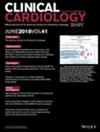A Clinical Study of Precision Chemoablation for Hypertrophic Obstructive Cardiomyopathy Without Large Interventricular Septal Branches
Abstract
Objective
This study aims to evaluate the clinical efficacy and safety of ultrasound-guided percutaneous septal precision chemical ablation in the treatment of hypertrophic obstructive cardiomyopathy (HOCM).
Methods
From December 2020 to July 2024, 27 patients with HOCM without large target septal branches (diffuse multiple branches, all less than 1 mm in diameter) were enrolled and underwent ultrasound-guided percutaneous septal chemical ablation. Intraoperative left ventricular outflow tract gradient (LVOTG), postoperative cardiac troponin I (cTnI), complications, and changes in the 36-Item Short Form Survey (SF-36) score, New York Heart Association (NYHA) functional classification and echocardiography parameters in 1 year post-PTSMA were monitored and analyzed.
Results
Immediate postoperative LVOTG values monitored by catheter and echocardiography were both significantly decreased (both p < 0.05) in the 27 patients, whereas the cTnI level was increased after PTSMA treatment (p < 0.05). One patient developed transient complete right bundle branch block during the procedure. At the 1-year follow-up, these patients showed significantly increased scores in all the eight domains of the SF-36 scale, and markedly improvement in echocardiography-based LVOTG value (p < 0.05) and NYHA functional classification (p < 0.05). However, no significant change were observed in the mean interventricular septal thickness (IVSTh) and left ventricular ejection fraction (LVEF) before and after operation (p > 0.05).
Conclusion
Ultrasound-guided precision PTSMA with gelatin sponge is a safe and effective treatment approach for HOCM patients, which can reduce the left ventricular outflow tract obstruction and greatly improve the life quality of the patients.


 求助内容:
求助内容: 应助结果提醒方式:
应助结果提醒方式:


